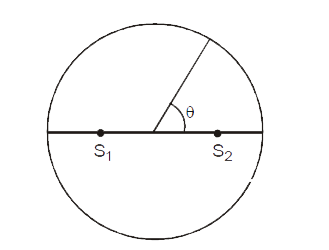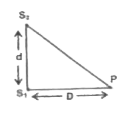In the shown fig. S1 and S2 are two identical coher- ent sources of sound, separated by a distance d. A receiver moves along the line XY (which is parallel to line S1 S2) to detect the intensity of sound at various points on the line. Distance of line XY from line S1 S2 isD(>>d). Point O is the foot of perpendicular bisector of the line S1 S2 on XY. Distance of first intensity maxima (on line XY) measured from O is y. Find percentage change in value of y if the temperature of air increases by 1%.

The correct Answer is:0.005
Step by step video, text & image solution for In the shown fig. S1 and S2 are two identical coher- ent sources of sound, separated by a distance d. A receiver moves along the line XY (which is parallel to line S1 S2) to detect the intensity of sound at various points on the line. Distance of line XY from line S1 S2 isD (gt gt d). Point O is the foot of perpendicular bisector of the line S1 S2 on XY. Distance of first intensity maxima (on line XY) measured from O is y. Find percentage change in value of y if the temperature of air increases by 1%. by Physics experts to help you in doubts & scoring excellent marks in Class 12 exams.
Updated on:21/07/2023Topper's Solved these Questions
Similar Questions
Assume that an electron and a position pair is formed from a gamma ray photon having energy 3.0 MeV. Find the total kinetic energy of the positron and the electron that is formed.
View SolutionThe brightness of an incandescent light bulb is con- trolled by a regulator. The regulator is a variable resistor connected in series with the bulb. What happens to the colour of the light given off by the bulb as the resistance of the regulator is increased? What happens to the average energy of photons given out by the bulb? Does it increase?
View SolutionLet S1 and S2 be two circles. S1 is tangent to x-axis and S2 is tangent to y axis and the straight line y = mx touches both circle at their common point. If centre of the circle S1 is (3,1), then radius of circle S2 is p/q, Find the least value of (p+q)
View SolutionConsider two statements S1 && S2 as s1: Radical Axis is identical to common chord of two circles which are intersecting S2: Radical Axis is locus of all such points such that lengths of tangents drawn from it to two circles are equal
View SolutionTwo speakers S1 and S2 are a driven by same source. You walk along a line l that is perpendicular bisector of the line joining the two speakers and record the intensity at different points. Then you walk along a line m that is parallel to the line joining the speakers and record the intensity of sound at various points. On which path you observe the loudness to alternate between faint and loud? Explain.

View SolutionIn a young’s double slit experiment the distance between slits S1 and S2 is d and distance of slit plane from the screen is D(>>d). The point source of light (S) is placed a distance d2 below the principal axis in the focal plane of the convex lens (L). The slits S1 and S2 are located symmetrically with respect to the principal axis of the lens. Focal length of the lens is f(>>d).
Find the distance of the central maxima of the fringe pattern from the centre (O) of the screen.
View SolutionTwo source of sound S1 and S2 produce sound waves of same frequency 660 Hz. A listener is moving from source S1 towards S2 with a constant speed um/s and he hears 10 beat/s. Then, u is equal to ________ (in m/s).
View SolutionTwo point sources of sound are placed at a distance d and a detector moves on a straight line parallel to the line joining the sources as shown in figure. At a distance D away from sources. Initially Detector is situated on the line so that it is equidistant from both the sources. Find the displacement of detector when it detects nth maximum sound and also find its displacement when it detects nth minimum sound.

View SolutionA train S1, moving with a uniform velocity of 108 km/h, approaches another train S2 standing on a platform. An observer O moves with a uniform velocity of 36 km/h towards S2, as shown in figure. Both the trains are blowing whistles of same frequency 120Hz. When O is 600 m away form S2 and distance between S1 and S2 is 800 m, the number of beats heard by O is ....... [Speed of the sound = 330 m/s]

View SolutionTwo point sources ofsound are placed at a distance d and a detector moves on a straight line parallel to the line joining the sources as shown in figure-6.27 at a distance D away from sources. Initially Detector is situated on the line so that it is equidistant from both the sources. Find the displacement of detector when it detects n^(th) maximum sound and also find its displacement when it detects n^(th) minimum sound.
View SolutionFind ratio of charges S1 and S2 of they are connected by wire.

View SolutionA particle is moving along a straight line whose v-s graph is shown, the dashed line is tangent to the curve. The magnitude of acceleration is ( in m/s2)
View SolutionTwo sources S1 and S2 emitting light of wave lengths 600 nm are placed a distance 1.0 x 102 cm apart..A detector can be moved on the line which is perpendicular to SiS2 . Find out the position of first.minimum detected.

View SolutionA vessel ABCD of 10 cm width has two small slits s1 and S2 sealed, with identical glass plates of equal thickness. The distance between the slits is 0.8. mm. POQ is the line perpendicular to the plane AB and passing through O, the middle point of S1 and S2. A monochromatic light source is kept al S. 40 cm below P and 2m from the vessel, to illuminate the slits as shown in the figure below. 40cm Calculate the position of the central bright fringe on the other wall CD with respect to the line OQ. Now, a liquid is poured into the vessel and filled up to-OQ. The central bright fringe is found to be at Q. Calculate the refractive index of the liquid
View SolutionIn Young's double slit experiment shown in figure S1 and S2 are coherent sources and S is the screen having a hole at a point 1.0 mm away from the central line. White light (400 to 700nm) is sent through the slits. Which wavelength passing through the hole has strong intensity?
View Solution
